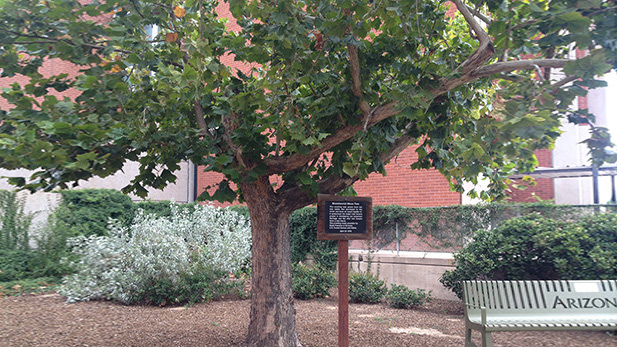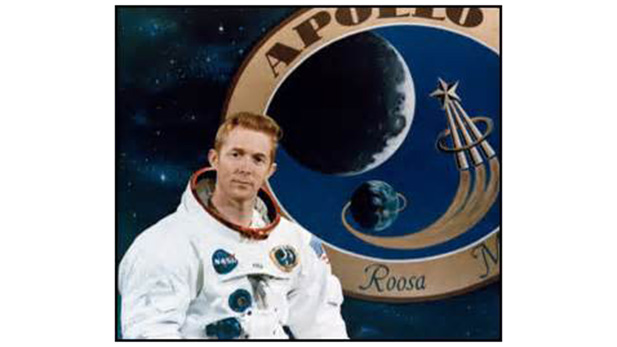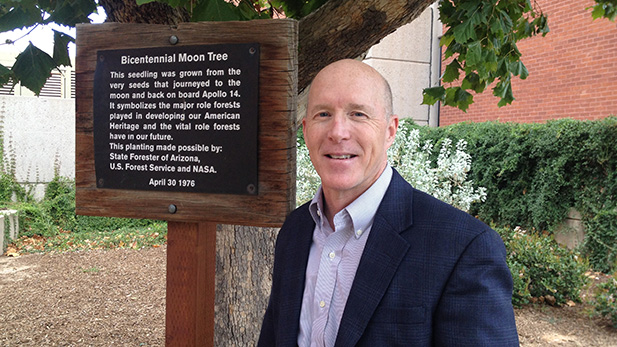 An American sycamore tree that grew from seeds flown to the Moon on Apollo 14 has stood next to the University of Arizona's Kuiper Space Sciences Building since April 1976.
An American sycamore tree that grew from seeds flown to the Moon on Apollo 14 has stood next to the University of Arizona's Kuiper Space Sciences Building since April 1976.Listen to the extended interview with Jack Roosa
By Sara Hammond, Arizona Science Desk
Jack Roosa had anything but a typical childhood. In the Houston area where he lived in the 1960s, among his playmates were the Armstrong, Aldrin and Shepard kids.
Most everyone in the neighborhood was working for NASA.
Roosa’s father, Stuart, was the command module pilot for Apollo 14, and among his accomplishments aboard that scientifically focused mission was caring for 500 tree seeds that orbited the Moon in early 1971. The seeds were germinated when they returned to Earth, and many of the seedlings were planted around the country in 1976 as “Moon Trees.”
An American sycamore tree cultivated from those seeds stands on the University of Arizona campus between the Flandrau Science Center and the Kuiper Space Sciences Building.
Jack Roosa, a retired Air Force pilot who lives in Tucson, will keynote the Lunar and Planetary Laboratory’s Moon Tree celebration, Oct. 30 at 4:30 p.m. in the Kuiper Building, 1629 E. University Blvd.
Roosa said his father had been an Air Force test pilot before admission to NASA’s astronaut corps. He and his siblings were used to having their dad away from home for stretches at a time.
 Apollo 14 astronaut Stuart Roosa
Apollo 14 astronaut Stuart RoosaAs the Apollo 14 launch date drew near, activity picked up. Joan Roosa schooled her children in manners and being ready for the onslaught of media attention.
Jack Roosa recalls going to Kennedy Space Center to watch his father blast off into space. The astronaut families sat together two and a half miles from the launch pad, close to the giant countdown clock. He can still recount the feeling and sound of the 7.5 million pounds of thrust of the Saturn V rocket that powered the astronauts into space.
“I’d never felt something that powerful in my life, nor since,” Roosa said.
Roosa said he went to Cape Canaveral for the Apollo 7 and 11 launches as well. At the Apollo 11 launch, which sent the first crew to land on the Moon in 1969, Roosa got to meet his childhood hero Charles Lindbergh.
While their father was orbiting the Moon, the family monitored live transmissions between Mission Control in Houston and the spacecraft via a “squawk box” that was in their mother’s bedroom.
“I could hear Mission Control talking to my dad and Alan Shepard and Ed Mitchell and then the responses coming back. It was really neat to be able to understand that your father is hundreds of thousands of mile away and you can year his voice,” Roosa said.
Roosa said he is eager to learn more about the Moon Tree program, starting in Tucson. He doesn’t know if his father attended the planting and hopes someone at the Moon Tree ceremony might have been present for the 1976 event and can offer details. Stuart Roosa did travel around the country during the bicentennial year helping to plant the trees from the seeds he carried to the Moon.
The Arizona Science Desk is a collaboration of public broadcasting entities in the state, including Arizona Public Media.
 Jack Roosa stands near the American sycamore tree grown from seeds his father, astronaut Stuart Roosa, took to the Moon on Apollo 14. The tree was planted next to the University of Arizona's Kuiper Space Sciences Building in 1976.
Jack Roosa stands near the American sycamore tree grown from seeds his father, astronaut Stuart Roosa, took to the Moon on Apollo 14. The tree was planted next to the University of Arizona's Kuiper Space Sciences Building in 1976.
By submitting your comments, you hereby give AZPM the right to post your comments and potentially use them in any other form of media operated by this institution.